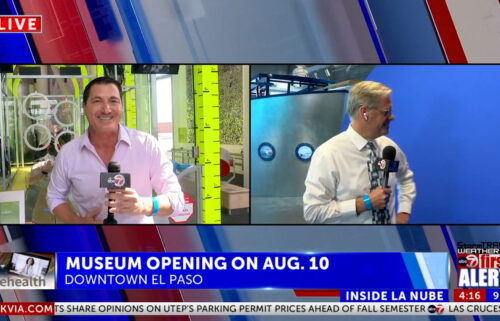Pastors talk about how COVID-19 has changed outreach
Click here for updates on this story
FREMONT, Neb. (Fremont Tribune) — The Rev. Judy Johnson can see how coronavirus restrictions have propelled her churches into a different form of ministry.
Johnson is pastor of Elim and St. Paul Lutheran churches in rural Hooper.
In the wake of COVID-19, churches closed their doors in March after Nebraska Gov. Pete Ricketts announced restrictions for places of worship to help slow the virus’ spread.
Some churches, which previously broadcast their worship services on television or via social media, continue to do so albeit with a group of 10 or fewer people involved in producing them.
For Johnson’s churches, the restrictions have opened the door to a new opportunity — outreach via the internet and social media.
“It’s something we often talked about doing, but the COVID-19 crisis pushed us into another new direction,” Johnson said. “We wanted to have a presence and be able to offer people the opportunity to worship even when we couldn’t be together.”
Today, many pastors — like the Rev. Mike Washburn — believe the pandemic will affect how churches minister in the future.
“I think it’s going to have a huge impact on our creativity and intentionality in ministering to a wider audience, whether that’s through electronic means or helping people in need,” said Washburn, lead pastor of Full Life Church in Fremont. “I think it will have a pretty wide-ranging, long-term impact.”
Washburn sees churches continuing online ministry that began either before or during the pandemic.
“I think churches will continue to Livestream, which a lot of them were not doing,” Washburn said. “I think they’ll find lots of different ways to creatively get into people’s lives, whether it’s through the internet or through service projects that will enhance their ministry.”
The Rev. Jeremy Henderson, lead pastor of Fremont Nazarene Church, believes many churches will have a greater awareness of the need for an online presence.
“There will always be people returning to the physical location of the church, but there’s definitely going to be a shift of people who will find online options of worship and discipleship as something they will utilize,” Henderson said.
Churches will continue to offer both alternatives.
“It’s not going to be an ‘either/or’ situation anymore for churches,” Henderson said. “I think it’s going to be a ‘both/and’ situation.”
Henderson said he’s seen an increase in numbers of people viewing services provided via Facebook.
Before COVID-19, the services might have 50 to 100 views.
“On a sermon now, we’re now seeing, consistently, over 400,” he said. “We also have people from different states who are tuning in to our services. We’ve had people from Washington state, South Dakota, Ohio. We even had somebody from the Philippines tune in one Sunday.”
Henderson’s church isn’t the only one seeing the viewer increase.
“The research I’m reading is other denominations are seeing an increase of viewership as well across multiple platforms,” Henderson said.
Full Life has seen an increase of about 200 to 400 or 500 views on Facebook, Washburn said.
Viewers have hailed from Cambodia, Africa, Pakistan, India and Romania, along with other states such as New Hampshire, New York and Maryland. The pastor has had many friend requests from these places.
Johnson and her churches have incorporated various ministry tools since they stopped having in-person services in mid-March.
For the services, which last about 30 minutes, Johnson gives a sermon and a children’s sermon. She includes Scripture reading, two hymns and a benediction.
Johnson said the church has a tech expert who records and produces the services, which are recorded at Elim one week and St. Paul the next.
Services are posted on YouTube, the Facebook page for Elim and St. Paul and the pastor’s personal Facebook page.
Because several members don’t have internet, the church secretary sends out printed copies of the sermon, Scriptures and prayers for them to read at home.
SPONSORED
BY TAKEDA.COM
Sponsored Video
Watch to learn more
SEE MORE
“They have really appreciated that,” Johnson said. “It’s been a real positive.”
On her personal Facebook page, Johnson also posts an online daily devotion sent out by Luther Seminary in St. Paul, Minn. The devotion includes a small Scripture and a prayer. In all, the devotional takes between three to five minutes to read.
“People have really responded to that well, too,” Johnson said.
Johnson misses her congregations and looks forward to the day when they can gather in the churches again. She believes services will continue to be recorded and posted to Facebook and YouTube and suspects the churches will send out fewer printed copies of sermons once congregants can meet in the buildings again.
A question remains if COVID-19 will have a permanent effect on church experiences such as passing offering plates, offering Sunday school or conducting community service projects.
“I think it will change general awareness of best practices, but I don’t know that it’s going to change those experiences that much in the long haul,” Washburn said. “It will certainly in the short run. In the long run I think they’ll return to very similar to the past.”
Henderson believes the coronavirus pandemic is making people more aware of individuals with pre-existing health conditions, those who are more elderly, and those more susceptible to other viruses besides COVID-19.
He believes people are becoming more aware of putting others’ needs ahead of their own.
And with greater use of technology, churches are extending their outreach.
“It’s where the people are at,” Henderson said. “For churches, it’s not shutting down the building so much, because that’s never been what the church has been about anyway. It’s another means for us to go where people are at — to share the good news.”
Please note: This content carries a strict local market embargo. If you share the same market as the contributor of this article, you may not use it on any platform.




